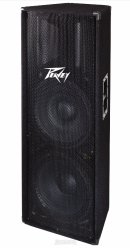Please help. I am in a local band that gigs twice weekly and we have blown a crossover inside one of our main speakers. I do realize that building my own would be the best way to go but I simply do not have the time and/or skill and need to replace it ASAP. Of course the company that makes these speakers does not sell replacement parts. Could someone please help me by telling me what I would need to buy to replace this crossover? Here are the specs on the speakers....
Dual 15" woofers
High compression titanium 25oz horn driver
Carpet finish
Steel corners & Heavy duty handles
Inputs: Dual 1/4" and Dual Speakon
Weight: 92lbs./ 41.7kgs.
Size: 48” (H) x 21.4” (W) x 20.4” (D)
Woofer Magnet: 650z
Driver: 250z
Frequency: 50Hz-21KHz
Max Power: 1000W
RMS Power: 500W
Warranty: 1 Year
Please let me know if you need more info!
PS - I do know that the crossover is a 2-way
Dual 15" woofers
High compression titanium 25oz horn driver
Carpet finish
Steel corners & Heavy duty handles
Inputs: Dual 1/4" and Dual Speakon
Weight: 92lbs./ 41.7kgs.
Size: 48” (H) x 21.4” (W) x 20.4” (D)
Woofer Magnet: 650z
Driver: 250z
Frequency: 50Hz-21KHz
Max Power: 1000W
RMS Power: 500W
Warranty: 1 Year
Please let me know if you need more info!
PS - I do know that the crossover is a 2-way
You ask for help without giving pertinent info, grasping at the straw!
Who cares that the thing is covered with carpet and has handles
Make, model. The problem (blown covers a lot of stuff, just like the word)
Sometimes these things have fuses (to protect the mfg's warranty). If you find one: do not replace it with a metal rod! E
Who cares that the thing is covered with carpet and has handles
Make, model. The problem (blown covers a lot of stuff, just like the word)
Sometimes these things have fuses (to protect the mfg's warranty). If you find one: do not replace it with a metal rod! E
Yes, we really need more information. What you have asked is the same as saying you need a new tire for your car without any more info. Give us as much as you can, even pulling out the XO (often mounted to the back of the terminal cup) and post some pics. It might be as simple as replacing a lighbulb (No, not kidding, they are used as protection devices inside PA speakers.)
Check for blown capacitors, bad solder joints, cracked circuit board, open protection devices (light bulb, fuse, breaker). Sketch a schematic and figure out where the sound stops (try hooking up another speaker to using jumper clips.) And make sure the drivers aren't blown.
- Status
- This old topic is closed. If you want to reopen this topic, contact a moderator using the "Report Post" button.
